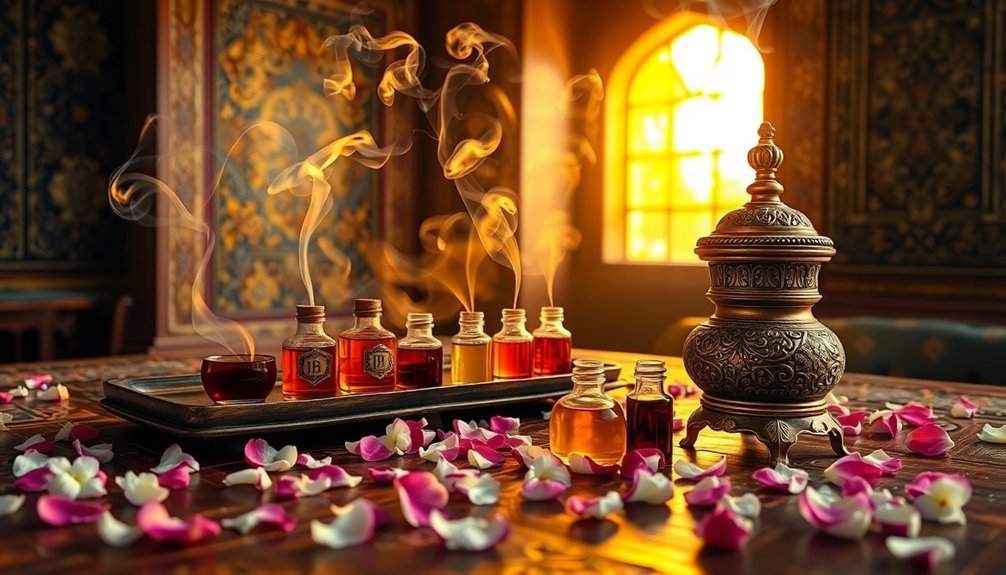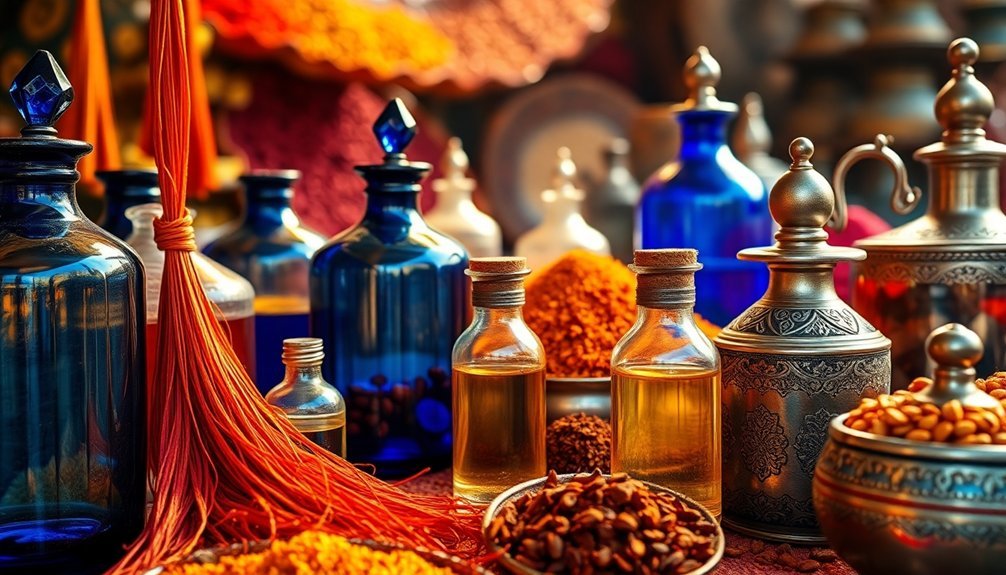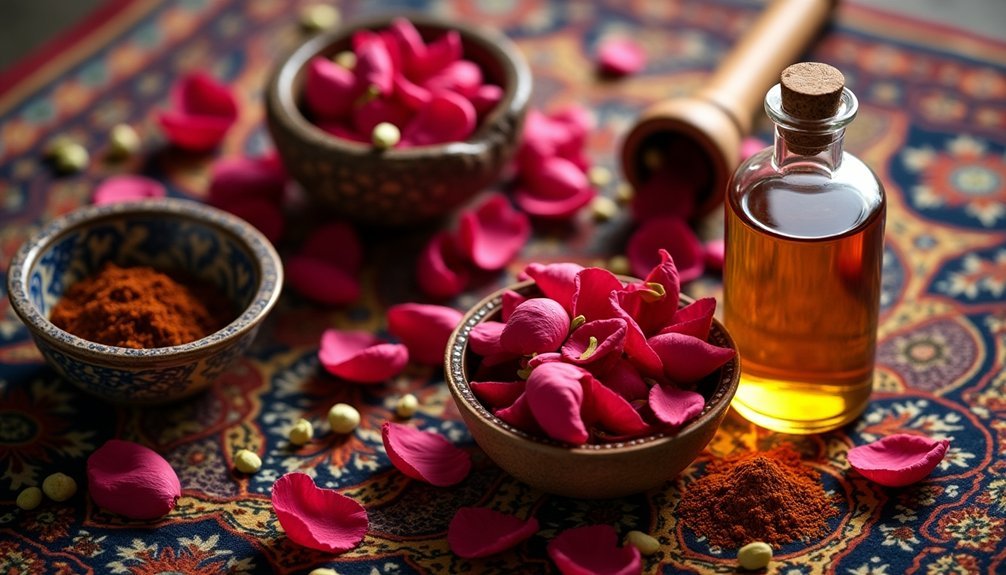Ancient Persian perfumes transport you to a world of royal courts and sacred temples, where master perfumers crafted exquisite fragrances using precious ingredients like saffron, rose, and rare resins. You'll discover five legendary recipes: the Royal Rose and Saffron Elixir, Musk and Ambergris Blend, Sacred Temple Incense, Imperial Esporghami Mix, and Spice Market Fragrance. Each blend carries centuries of Persian elegance, offering you a glimpse into the aromatic treasures that once graced nobility.
Royal Persian Rose and Saffron Elixir

Luxury and sophistication define the Royal Persian Rose and Saffron Elixir, a timeless fragrance that combines two of Persia's most treasured ingredients.
You'll discover the delicate balance of rose, known as "the flower of heaven," blending seamlessly with the warm, honey-like notes of precious saffron.
To create this royal fragrance, you'll need to follow ancient Persian distillation methods. Start by extracting rosewater from fresh petals, then carefully infuse saffron in oil to release its aromatic compounds.
When you combine these elements, you're recreating a perfume once reserved for nobility in Persian courts. The result is an enticing blend of floral and spicy notes that'll transport you to bustling ancient bazaars. Each drop creates a unique interaction with skin, making every wearer's experience distinctly personal.
This traditional recipe continues to influence modern perfumery, carrying forward a legacy of Persian elegance.
Ancient Musk and Ambergris Blend
Two of antiquity's most prized aromatics, musk and ambergris, formed the foundation of this legendary Persian blend.
You'll discover how Persian perfumers expertly combined these rare ingredients with carrier oils and complementary aromatics to create a luxurious fragrance that symbolized wealth and sophistication.
The careful process involves melting fine ambergris before combining it with the other ingredients, ensuring proper integration of the scents.
To recreate this ancient blend, you'll need:
- Musk essence (as the primary aromatic base)
- Ambergris tincture (as a fixative and unique scent)
- Sweet almond oil (as the carrier)
- Rose water (for floral complexity)
- Select resins and spices (to enhance depth)
Mix these ingredients carefully, following the Persian tradition of dissolving them in alcohol or blending with oils.
While the original blend was reserved for nobility, you're now experiencing a fragrance that once graced the Persian royal courts.
Sacred Temple Incense Perfume

While royal Persian perfumes adorned the elite, an equally enchanting blend emerged from ancient temples. You'll find this sacred incense perfume combines frankincense and myrrh with aromatic juniper berries and cypress grass, creating a divine connection during religious ceremonies. Terebinth resin, with its distinctive pine-like aroma, was often incorporated into these sacred blends.
To craft this temple blend, you'll need to grind these precious ingredients together, then dissolve them in almond or sesame oil. The addition of honey and wine deepens the fragrance, while cinnamon and cardamom provide warming notes that rise with the smoke.
You'll notice this recipe reflects Zoroastrian influences, where burning specific aromatics was believed to ward off evil and guarantee divine protection. This perfume wasn't just for pleasure – it served as a bridge between the earthly and divine domains, embodying ancient Persian spiritual traditions.
Imperial Esporghami and Jasmine Mix
Ancient Persian royalty cherished the Imperial Esporghami and Jasmine Mix as their signature fragrance.
You'll find this luxurious blend combines the finest ingredients sourced from the Silk Road, creating a scent that's both regal and sophisticated.
The perfume requires careful blending of jasmine absolute, rose essential oil, and esporghami (likely a form of lavender), all suspended in high-quality base oils.
To create this imperial fragrance, you'll need:
- Fresh rose petals or rose essential oil for the primary floral note
- Premium jasmine absolute for deep, sweet undertones
- Esporghami herbs for their calming properties
- A carrier oil like almond or sesame
- Selected spices and resins for warmth and depth
Let your blend age properly to allow the fragrances to mature and develop their full character.
Persian Spice Market Fragrance

Drawing inspiration from the vibrant bazaars of Persia, the Spice Market Fragrance captures the exotic aromas that have enchanted traders and perfumers for centuries. You'll discover the perfect blend of Damascus rose and saffron, anchored by warm cinnamon and cardamom notes, with frankincense providing a mysterious depth.
| Ingredient | Traditional Role |
|---|---|
| Damascus Rose | Heart note, adds floral complexity |
| Saffron | Warm, earthy undertone |
| Cinnamon | Sweet, spicy foundation |
| Cardamom | Fresh, aromatic lift |
| Frankincense | Deep, resinous base |
To craft this authentic fragrance, you'll need to follow time-honored Persian blending techniques. Let your ingredients age naturally, allowing the spices to meld with the floral notes. The result is a luxurious scent that evolves on your skin, revealing layers of aromatic complexity that transport you to the ancient spice routes of Persepolis.
Frequently Asked Questions
How Long Can Traditional Persian Perfumes Be Stored Before Losing Their Potency?
You'll find that properly stored traditional Persian perfumes can last decades or even a lifetime. If you keep them in cool, dark places and tightly sealed containers, they'll maintain their potency remarkably well.
What Tools Were Essential for Making Perfumes in Ancient Persian Workshops?
You'll need an alembic for distillation, cold enfleurage trays, heating vessels for maceration, gardening tools for plant harvesting, and specialized storage bottles to make perfumes in ancient Persian workshops.
Did Ancient Persians Use Different Perfumes for Different Seasons?
You won't find evidence of seasonal perfume use in ancient Persia. They chose fragrances based on social status and symbolic meaning rather than the time of year. It's a common misconception about their perfume traditions.
How Did Common People Afford Expensive Ingredients Like Saffron and Ambergris?
You'll find that common people rarely used pure saffron or ambergris. Instead, they'd opt for cheaper substitutes, share small amounts within communities, or access these luxuries through religious institutions and public ceremonies.
What Methods Did Ancient Persians Use to Test Perfume Quality?
You'll find ancient Persians tested perfumes through sensory evaluation, royal endorsements, and public reception at festivities. They also conducted extensive distillation experiments in workshops and used quality control in fragrance-making facilities.
In Summary
Now you're equipped with five authentic Persian perfume recipes that have enchanted royalty and commoners alike for centuries. Whether you're drawn to the luxurious rose and saffron blend or the mystical temple incense, you'll find these fragrances transport you to ancient Persia's aromatic bazaars and palatial gardens. Don't hesitate to experiment with these time-tested formulas – you're continuing an artistic tradition that's over 2,500 years old.
References
- https://www.scentopia-singapore.com/ancient-perfume-recipe-333217.html
- https://www.hearthandhomesteadstore.com/product-page/persian-vanilla-natural-perfume-oil
- https://luxeperf.com/what-would-a-persian-perfume-smell-like/
- https://tile.loc.gov/storage-services/master/gdc/gdcebookspublic/20/20/05/43/34/2020054334/2020054334.pdf
- https://beautinow.com/origins-history-of-perfume/ancient-persian-perfume-history/
- https://frater.com/products/eram
- https://georgianera.wordpress.com/tag/ambergris-perfume/
- https://www.manuscriptcookbookssurvey.org/ambergris-the-perfume-of-whales-that-once-scented-foods/
- http://perfumeshrine.blogspot.com/2011/10/ambergris-laced-chocolate-other-uses-of.html
- https://en.wikipedia.org/wiki/Frankincense





Leave a Reply